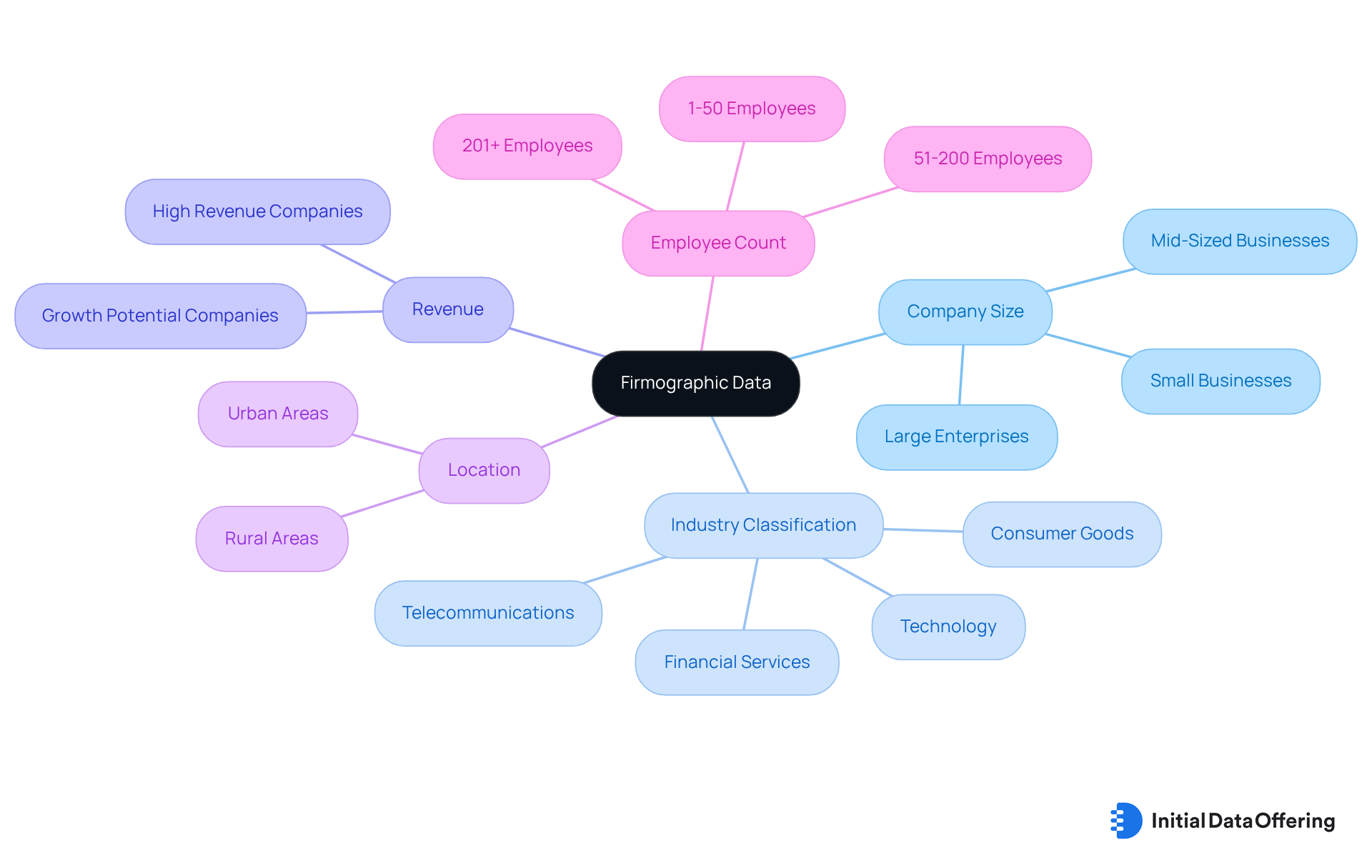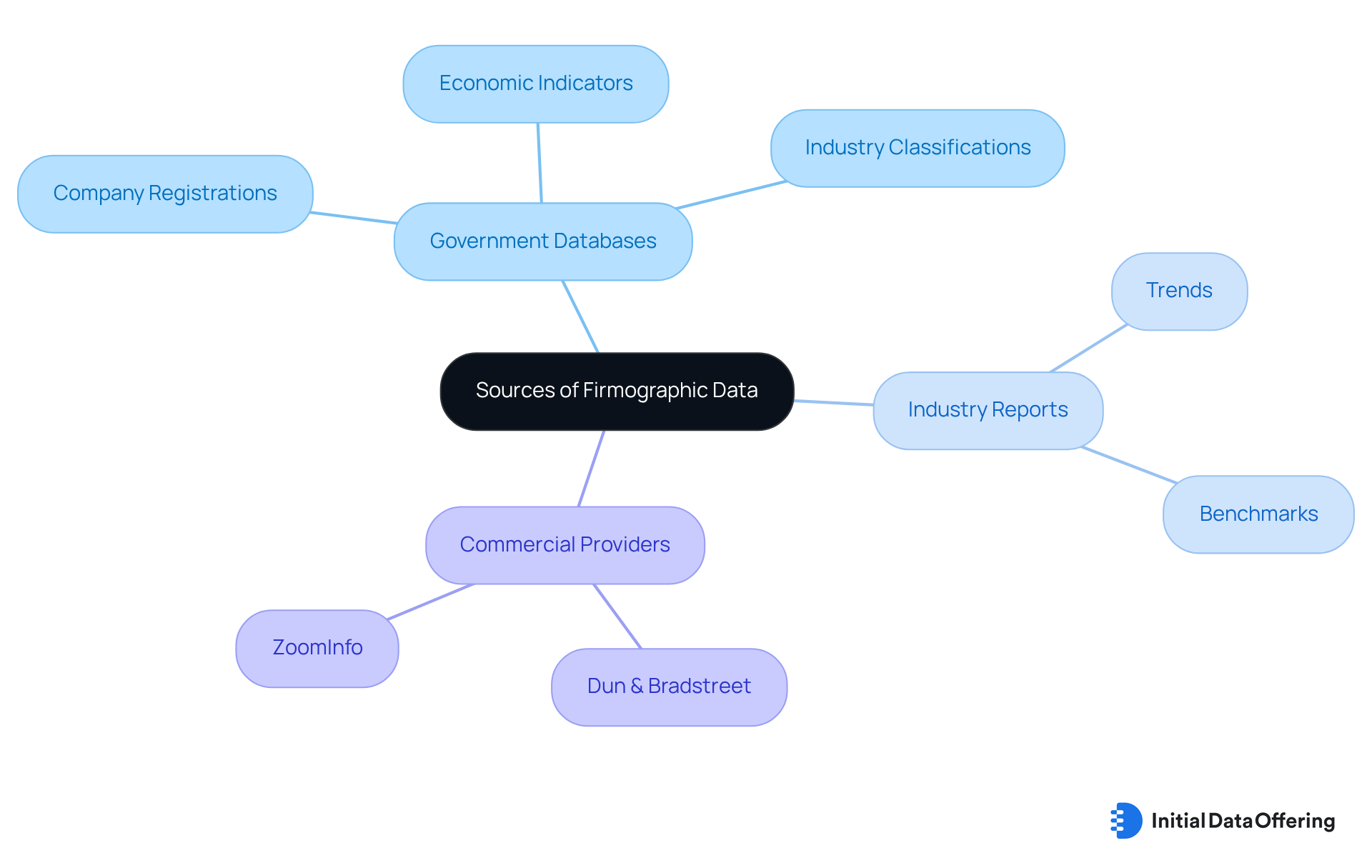Firmographic Meaning: Understanding Its Role and Importance

Firmographic Meaning: Understanding Its Role and Importance
Overview
Firmographic meaning refers to the attributes and characteristics of companies, such as size, industry classification, and revenue. These elements are crucial for effective market segmentation and targeted marketing strategies. By leveraging firmographic data, organizations can tailor their promotional efforts, enhance customer engagement, and improve conversion rates. Understanding target markets better leads to more effective marketing outcomes.
How can your organization utilize firmographic data to refine its marketing approach?
Introduction
Understanding the intricate tapestry of firmographic data is essential for businesses striving to thrive in competitive markets. This type of information includes key attributes such as company size, industry, and revenue. These features serve as powerful tools for market segmentation and targeted marketing strategies. However, the challenge lies in effectively leveraging this data to identify potential clients and engage them meaningfully.
How can organizations harness the insights derived from firmographic meaning to enhance their marketing efforts and drive sustainable growth? By exploring these aspects, businesses can unlock the full potential of firmographic data.
Define Firmographic Data: Key Concepts and Characteristics
Firmographic meaning encompasses the attributes and characteristics of companies, which are essential for effective market segmentation and analysis. Much like demographic information pertains to individuals, organizational characteristics include crucial details such as:
- Company size
- Industry classification
- Revenue
- Location
- Employee count
These traits enable companies to gain a deeper understanding of their target markets, allowing them to adjust their promotional strategies accordingly. For example, a telecommunications firm might analyze company information to identify small enterprises in rural areas, facilitating targeted promotional efforts that resonate with this specific audience.
As we approach 2025, the growing importance of firmographic meaning is evident, as businesses increasingly rely on this knowledge to refine their strategies and enhance customer engagement. By leveraging firmographic meaning, companies can develop personalized marketing initiatives that improve conversion rates and foster stronger relationships with potential clients. Industry specialists emphasize that utilizing organizational information is vital for companies aiming to differentiate themselves in competitive markets and uncover new growth opportunities.
Furthermore, market leaders are defined as firms with the highest annual revenue within their sector, underscoring the significance of organizational information in identifying these key players. Detailed segmentation can enhance campaign effectiveness by providing a clearer understanding of prospective clients. It is also crucial to adhere to privacy regulations and industry standards when utilizing demographic information, ensuring that companies maintain ethical practices.
Lastly, verifying the freshness and relevance of information sources is critical for ensuring the accuracy of firmographic meaning, ultimately supporting effective marketing strategies. How can your organization leverage firmographic insights to enhance its marketing efforts and drive growth?

Explore Applications: Who Uses Firmographic Data and Why
Firmographic meaning serves as a crucial asset for marketers, sales teams, and analysts. Marketers leverage this data to craft targeted campaigns that resonate with specific market segments, ensuring their messaging is relevant and impactful. For instance, Personio effectively employed business segmentation to tailor its promotional strategies for small and medium-sized enterprises, resulting in a 16% increase in demo signups.
As highlighted, firmographic meaning within segmentation helps firms better understand their target audience, which will in turn provide better marketing returns. Sales teams utilize company-specific insights to pinpoint high-potential leads, prioritizing outreach based on key characteristics such as size and industry. This approach not only streamlines their efforts but also boosts conversion chances, as firmographic meaning assists your Marketing and Sales teams in concentrating on the leads that are the most suitable for your organization.
Furthermore, business analysts harness demographic information to evaluate market trends and competitive landscapes, empowering organizations to make informed strategic decisions. For example, a financial services company might analyze business data to identify rapidly growing sectors, allowing them to adjust their offerings to meet emerging demands.
LinkedIn exemplifies the significance of business-related information, categorizing nearly 1 billion users by sector, company size, location, and job title, thereby enhancing promotional effectiveness. By integrating demographic insights into their strategies, organizations can markedly improve their marketing effectiveness and overall performance.

Identify Sources: Where Firmographic Data Comes From
Firmographic information can be obtained from a variety of channels, including government databases, industry reports, and commercial providers. Government organizations frequently release information pertaining to company registrations, economic indicators, and industry classifications. This data serves as a fundamental source for demographic analysis, offering insights that are crucial for informed decision-making. Additionally, industry reports from market research firms provide insights into specific sectors, highlighting trends and benchmarks that can guide strategic planning.
Commercial information providers, such as Dun & Bradstreet and ZoomInfo, offer extensive databases that compile organizational information from various sources. This capability enables companies to access detailed profiles of prospective clients, enhancing their ability to target and engage effectively. By leveraging these sources, organizations can ensure they have accurate and up-to-date firmographic meaning, which is essential for maintaining a competitive edge in their respective markets.
How might these datasets influence your approach to market analysis and client engagement?

Understand Importance: The Role of Firmographic Data in B2B Marketing
Firmographic meaning plays a pivotal role in B2B promotion by enabling businesses to segment their target audience effectively. Understanding the traits of potential clients allows companies to customize their promotional messages and product offerings to meet the specific needs of different segments.
For instance, a company providing enterprise software may concentrate its promotional efforts on large corporations with specific revenue thresholds. This targeted approach ensures that their messaging aligns with the challenges faced by these organizations.
Additionally, business-related information assists in lead evaluation and prioritization. This capability enables sales teams to focus their efforts on the most promising prospects.
Ultimately, leveraging firmographic meaning enhances the efficiency and effectiveness of B2B marketing strategies, driving better engagement and conversion rates.
How can your organization utilize this data to refine its marketing approach?

Conclusion
Firmographic meaning serves as a foundational element for businesses aiming to optimize their marketing strategies and enhance customer engagement. By understanding the organizational characteristics that define their target markets, companies can tailor their approaches to resonate more effectively with specific segments. This strategic alignment not only improves promotional relevance but also fosters deeper connections with potential clients.
Throughout the article, the significance of firmographic data is underscored, highlighting its critical role in market segmentation, targeted marketing campaigns, and lead prioritization. Key insights reveal how businesses can leverage firmographic information to identify high-potential leads, understand market trends, and refine their offerings based on industry-specific needs. For instance, successful applications like Personio’s targeted strategies illustrate the tangible benefits of utilizing firmographic insights.
Ultimately, the effective use of firmographic data is not just about gaining a competitive edge; it is about making informed decisions that drive growth and enhance marketing effectiveness. Organizations are encouraged to explore and integrate these insights into their strategies. How can your organization leverage firmographic data to ensure that your marketing efforts are not only efficient but also impactful? Embracing these strategies paves the way for sustainable success in an increasingly competitive landscape.
Frequently Asked Questions
What is firmographic data?
Firmographic data refers to the attributes and characteristics of companies, essential for effective market segmentation and analysis. It includes details such as company size, industry classification, revenue, location, and employee count.
Why is firmographic data important for businesses?
Firmographic data allows companies to gain a deeper understanding of their target markets, enabling them to adjust promotional strategies and develop personalized marketing initiatives that improve conversion rates and foster stronger relationships with potential clients.
How can companies use firmographic data for targeted marketing?
Companies can analyze firmographic information to identify specific segments, such as small enterprises in rural areas, and tailor promotional efforts that resonate with these audiences.
What role does firmographic data play in competitive markets?
Utilizing firmographic data is vital for companies aiming to differentiate themselves in competitive markets and uncover new growth opportunities by enhancing their understanding of prospective clients.
How are market leaders defined in relation to firmographic data?
Market leaders are defined as firms with the highest annual revenue within their sector, highlighting the significance of organizational information in identifying these key players.
What is the importance of verifying information sources in firmographic data?
Verifying the freshness and relevance of information sources is critical for ensuring the accuracy of firmographic data, which ultimately supports effective marketing strategies.
What ethical considerations should companies keep in mind when using firmographic data?
Companies must adhere to privacy regulations and industry standards when utilizing demographic information to ensure ethical practices.